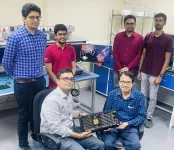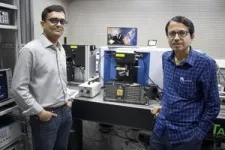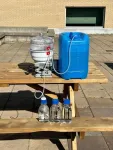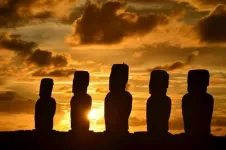(Press-News.org) In a landmark advancement, researchers at the Indian Institute of Science (IISc) have developed a brain-inspired analog computing platform capable of storing and processing data in an astonishing 16,500 conductance states within a molecular film. Published today in the journal Nature, this breakthrough represents a huge step forward over traditional digital computers in which data storage and processing are limited to just two states.
Such a platform could potentially bring complex AI tasks, like training Large Language Models (LLMs), to personal devices like laptops and smartphones, thus taking us closer to democratising the development of AI tools. These developments are currently restricted to resource-heavy data centres, due to a lack of energy-efficient hardware. With silicon electronics nearing saturation, designing brain-inspired accelerators that can work alongside silicon chips to deliver faster, more efficient AI is also becoming crucial.
“Neuromorphic computing has had its fair share of unsolved challenges for over a decade,” explains Sreetosh Goswami, Assistant Professor at the Centre for Nano Science and Engineering (CeNSE), IISc, who led the research team. “With this discovery, we have almost nailed the perfect system – a rare feat.”
The fundamental operation underlying most AI algorithms is quite basic – matrix multiplication, a concept taught in high school maths. But in digital computers, these calculations hog a lot of energy. The platform developed by the IISc team drastically cuts down both the time and energy involved, making these calculations a lot faster and easier.
The molecular system at the heart of the platform was designed by Sreebrata Goswami, Visiting Professor at CeNSE. As molecules and ions wiggle and move within a material film, they create countless unique memory states, many of which have been inaccessible so far. Most digital devices are only able to access two states (high and low conductance), without being able to tap into the infinite number of intermediate states possible.
By using precisely timed voltage pulses, the IISc team found a way to effectively trace a much larger number of molecular movements, and map each of these to a distinct electrical signal, forming an extensive “molecular diary” of different states. “This project brought together the precision of electrical engineering with the creativity of chemistry, letting us control molecular kinetics very precisely inside an electronic circuit powered by nanosecond voltage pulses,” explains Sreebrata Goswami.
Tapping into these tiny molecular changes allowed the team to create a highly precise and efficient neuromorphic accelerator, which can store and process data within the same location, similar to the human brain. Such accelerators can be seamlessly integrated with silicon circuits to boost their performance and energy efficiency.
A key challenge that the team faced was characterising the various conductance states, which proved impossible using existing equipment. The team designed a custom circuit board that could measure voltages as tiny as a millionth of a volt, to pinpoint these individual states with unprecedented accuracy.
The team also turned this scientific discovery into a technological feat. They were able to recreate NASA’s iconic “Pillars of Creation” image from the James Webb Space Telescope data – originally created by a supercomputer – using just a tabletop computer. They were also able to do this at a fraction of the time and energy that traditional computers would need.
The team includes several students and research fellows at IISc. Deepak Sharma performed the circuit and system design and electrical characterisation, Santi Prasad Rath handled synthesis and fabrication, Bidyabhusan Kundu tackled the mathematical modelling, and Harivignesh S crafted bio-inspired neuronal response behaviour. The team also collaborated with Stanley Williams, Professor at Texas A&M University and Damien Thompson, Professor at the University of Limerick.
The researchers believe that this breakthrough could be one of India’s biggest leaps in AI hardware, putting the country on the map of global technology innovation. Navakanta Bhat, Professor at CeNSE and an expert in silicon electronics led the circuit and system design in this project. “What stands out is how we have transformed complex physics and chemistry understanding into groundbreaking technology for AI hardware,” he explains. “In the context of the India Semiconductor Mission, this development could be a game-changer, revolutionising industrial, consumer and strategic applications. The national importance of such research cannot be overstated.”
With support from the Ministry of Electronics and Information Technology, the IISc team is now focused on developing a fully indigenous integrated neuromorphic chip. “This is a completely home-grown effort, from materials to circuits and systems,” emphasises Sreetosh Goswami. “We are well on our way to translating this technology into a system-on-a-chip.”
END
Neuromorphic platform presents huge leap forward in computing efficiency
2024-09-11
ELSE PRESS RELEASES FROM THIS DATE:
Genetics of dementia in African and underrepresented populations presented
2024-09-11
Regions of the genome associated with Alzheimer’s disease and dementia in African populations will be presented at the Future of Dementia in Africa conference on September 11-12, 2024. The studies highlight discrepancies compared to Caucasian populations and underscore that a lack of diversity in genomic studies potentially limits the effectiveness of targeted therapies across diverse populations.
The Future of Dementia in Africa conference will take place at the J.W. Marriott Hotel in Nairobi, Kenya. It is a Nature Conference, ...
Turning seawater into fresh water through solar power
2024-09-11
Researchers at the University of Waterloo have designed an energy-efficient device that produces drinking water from seawater using an evaporation process driven largely by the sun.
Desalination is critical for many coastal and island nations to provide access to fresh water, given water scarcity concerns due to rapid population growth and increasing global water consumption. Roughly 2.2 billion people worldwide have no access to clean water, emphasizing the urgent need for new technologies to generate fresh water, according to the UN World Water Development Report 2024.
Current desalination systems pump seawater through membranes to ...
How the oceans’ most abundant bacteria impact global nutrient flows
2024-09-11
If you were to collect all the organisms from the ocean surface down to 200 meters, you’d find that SAR11 bacteria, though invisible to the naked eye, would make up a fifth of the total biomass. These bacteria, also known as Pelagibacterales, have evolved to thrive in nutrient-poor marine environments and play a significant role in global nutrient cycles. Despite their importance, the mechanisms behind their impact on the planetary ecosystem have remained unclear.
But now, a recent Nature paper by researchers from the Okinawa ...
Discovery of a new phase of matter in 2D which defies normal statistical mechanics
2024-09-11
Physicists from the Cavendish Laboratory in Cambridge have created the first two-dimensional version of the Bose glass, a novel phase of matter that challenges statistical mechanics. The details of the study have been published in Nature.
As the name suggests, the Bose glass has some glassy properties and within it all particles are localised. This means that each particle in the system sticks to itself, not mixing with its neighbours. If coffee was localised, then when stirring milk into the coffee, the intricate pattern of black and white stripes would remain forever, instead of washing out to an average.
To create this new phase of matter, the group overlapped several laser ...
Genes with strong impact on menopause timing also link to cancer risk
2024-09-11
New research has found four genes with some of the largest known effects on the timing of menopause discovered to date, providing new insight into links between menopause timing and cancer risk.
Genes come in pairs, and when women only have one working copy of the four new genes identified (ETAA1, ZNF518A, PNPLA8, PALB2), they have menopause between two and five-and-a-half years earlier than average.
Published in Nature, the large-scale analysis was funded by the Medical Research Council and Wellcome. The team first looked at variation in data from genetic sequencing of 106,973 post-menopausal ...
Ancient DNA from Rapa Nui (Easter Island) refutes best-selling population collapse theory
2024-09-11
Rapa Nui or Te Pito o Te Henua (the navel of the world), also known as Easter Island, is one of the most isolated inhabited places in the world. Located in the Pacific, it lies over 1,900 km east of the closest inhabited Polynesian island and 3,700 km west of South America. Although the island, its inhabitants and their rich culture have been extensively studied by archaeologists, anthropologists and geneticists, two key elements of Rapanui history remain very controversial to this day. One of these is the theory of population collapse through "ecocide" or "ecological ...
Researchers combine the power of AI and the connectome to predict brain cell activity
2024-09-11
With maps of the connections between neurons and artificial intelligence methods, researchers can now do what they never thought possible: predict the activity of individual neurons without making a single measurement in a living brain.
For decades, neuroscientists have spent countless hours in the lab painstakingly measuring the activity of neurons in living animals to tease out how the brain enables behavior. These experiments have yielded groundbreaking insights into how the brain works, but they have only scratched the surface, leaving much of the brain unexplored.
Now, researchers are using artificial intelligence and the connectome – a ...
New research shows clinical trials inappropriately excluding people of African/Middle Eastern descent
2024-09-11
BOSTON – Many clinical trials of new cancer drugs may be inappropriately excluding some people with "Duffy-null phenotype," a trait found predominantly in people of African or Middle Eastern descent, researchers at Dana-Farber Cancer Institute and Queen Mary University of London report in a new study.
The Duffy-null phenotype results in relatively lower levels of white blood cells called neutrophils when measured in the blood. This is not because they have less neutrophils overall, but because they are more frequently located in other body tissues. Tests that restrict clinical trial eligibility to patients with certain blood levels of neutrophils may therefore ...
Examining the hypertension control cascade in adults with uncontrolled hypertension in the US
2024-09-11
About The Study: In this cross-sectional study, more than 50% of adults with uncontrolled hypertension in the U.S. were unaware of their hypertension and were untreated, and 70.8% of those who were treated had hypertension that remained uncontrolled. These findings have serious implications for the nation’s overall health given the association of hypertension with increased risk for cardiovascular disease.
Corresponding Author: To contact the corresponding author, LaTonia C. Richardson, PhD, email lcrichardson@cdc.gov.
To access the embargoed study: ...
Neighborhood child opportunity and preterm birth rates by race and ethnicity
2024-09-11
About The Study: In this cross-sectional study of neighborhood opportunity and preterm birth, elevated risk associated with exposure to a very low opportunity neighborhood, coupled with the disproportionate exposure by race and ethnicity, points to a modifiable factor that may contribute to racial and ethnic inequities in preterm birth. Future research should investigate interventions that seek to address neighborhood opportunity.
Corresponding Author: To contact the corresponding author, Candice Belanoff, ScD, MPH, email cbelanof@bu.edu.
To ...








